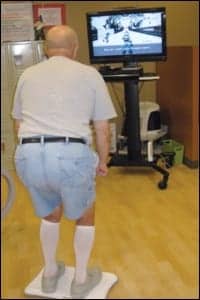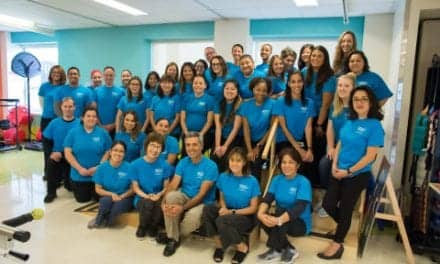
Balance and weight shifting from side to side are examples of functions that can be improved through therapeutic applications of the Wii gaming system.
A quote from an IBM manual, circa 1991, appearing on the Web site of Good Shepherd Rehabilitation Hospital, Allentown, Pa, states, “For people without disabilities, technology makes things easier. For people with disabilities, technology makes things possible.” That’s especially true for stroke patients in our neurorehabilitation program. We use many technologies during the rehabilitation process to help stroke patients return to their optimal level of function and independence. For years, Good Shepherd has been an early adopter of these technologies, often acting as a testing site for the device manufacturers. These technologies offer a leading-edge approach to rehabilitation and, when combined with the hands-on approach of therapists, help patients increase and maintain function following a stroke.
MATCHING TECHNOLOGY TO THE CONDITION
Technology is most effective when it targets a particular condition challenging our stroke patients, offering them additional options for regaining function. Foot drop is a good example of a condition that has benefited from new technology. Foot drop–the inability to dorsiflex the foot due to weakness or paralysis of the tibialis anterior and peroneal muscle–often manifests with patients demonstrating poor foot clearance. They overcompensate with excessive hip hiking, flexion, and circumduction, which results in a steppage gait.
Foot drop can be treated and managed via therapeutic exercise and neuromuscular reeducation. Technology also provides assistance for these patients via electrical stimulation neuroprosthetics. The e-stim device stimulates muscle reeducation, prevents atrophy, and promotes a more natural walking pattern. The device has three components that communicate with each other through wireless technology for real-time gait adaptations. A leg cuff positioned below the knee uses electrodes to stimulate the peroneal nerve. A gait sensor in the heel of a shoe communicates to the leg cuff when the heel strikes and during the swing phase to allow dorsiflexion and foot clearance at the appropriate gait phase. A handheld remote allows for adjustments to the stimulation based on patients’ needs. The device can be set to accommodate different speeds of walking and different terrain. Electrical stimulation devices have the added benefit of allowing patients to take the rehabilitation device home with them, increasing the device’s value to the patient.
This device has several psychological benefits. It is inconspicuous and looks like the knee braces worn by athletes after surgery. Patients are less self-conscious about wearing it in public. In addition, it can be worn with regular shoes. One 25-year-old poststroke patient who came to us for therapy was delighted to be able to incorporate the e-stim device into her rehabilitation because it allowed her to wear stylish shoes again.

The Tibion bionic leg is a robotic device that assists in the stance phase of gait in stroke patients who have weakness in one leg.
GAIT AND BALANCE TRAINING TECHNOLOGY
Other technologies are available for patients challenged by gait issues following stroke. Body weight support systems improve a patient’s ability to walk normally by improving gait patterns, quickening swing, and developing a more normal pattern to increase gait speed. The system uses an overhead suspension system and harness to allow the therapist to provide effective body weight-supported gait therapy. Off-weighting can be accomplished via an adjustable gauge and facilitates upright posture. The device can be used with a treadmill or on the floor, and the therapist helps pattern the correct movement for the patient. This may include facilitating proper limb placement or alignment.
A body weight support system can be especially effective for stroke patients with paralysis or weakness on one side of the body because it decreases the weight-bearing load on the affected side. If we can off-weight patients, they may start to move without having to make all kinds of postural adjustments. When balance is compromised or nonexistent, walking is often slow and asymmetric. If we can get a patient moving at a speed and level similar to that of their prestroke gait, they can tap into the pattern generators they have within their memory without it being a conscious effort.
Computerized balance training and assessment devices offer another option for clinicians working to get stroke patients—literally—back on their feet. The computerized balance equipment allows clinicians to assess such issues as sensory organization, motor control, and limits of stability. Sensory organization tests can be performed to identify components impairing balance and to define a patient’s midline orientation. The technology allows the clinician to pinpoint limits of stability to determine how far outside the base of support a patient can move in all directions. For example, standing on a force plate, the patient watches a moving object on a screen, striving to shift his balance from side to side with the object with a smooth, balanced movement. In other tests, righting reactions can be measured by moving walls surrounding a patient, or by moving the floor. Tests also can be performed to check motor control.

Computerized balance equipment allows clinicians to assess issues such as sensory organization, motor control, and limits of stability.
Using balance assessment equipment allows therapists to introduce a treatment plan specifically designed to address patient deficits. This might include standing from a seated position with symmetrical control on both legs, walking up and down stairs to overcome favoring a particular side, or standing with proper alignment on one leg. The technology also creates a record of patient balance scores to determine progress toward goals. With these records, progress can more easily be tracked.
ON THE CUTTING EDGE
Robotic devices use electronics and mechanical parts to help stroke patients perform difficult tasks by assisting a body part that no longer functions adequately. At Good Shepherd Rehabilitation Hospital, we are fortunate to be among the first in the country—and remain the first in our region—to use the Tibion bionic leg. This robotic device assists in the stance phase of gait in stroke patients who have weakness in one leg. It is one of the few new devices available that can be of assistance for people who are 2, 5, or more years post-stroke and who still seek improvement in ambulation and function.
The bionic leg wraps around the thigh, over the knee, and down to the calf. Sensors are placed inside the shoe. The therapist programs the device to predetermined levels for assistance and resistance. It is especially helpful in improving leg functionality for activities such as sit to stand, stand to sit, walking, and stair climbing. When a patient exerts a certain level of force in standing or walking, it is picked up by sensors in the bionic leg, which kicks in to provide added support to help the patient stand or walk.
One of our patients was a 55-year-old man who was 2 years post-stroke. Walking across a bridge over the Delaware River was part of his job before his stroke and, although he was able to return to work, he could not resume that activity because one of his legs remained externally rotated, making ambulation difficult. Through the use of the bionic leg, he was able to improve gait speed and endurance and now is able to walk the length of the bridge.
MAKING A GAME OF REHABILITATION

To read more on this topic, visit “A Team Approach to Stroke Rehab” and “After The Stroke.”
One piece of equipment that is increasingly used in outpatient rehabilitation might be found as close as your living room. The Wii gaming system has therapeutic application. Balance and weight shifting from side to side are examples of functions that can be improved through use of the Wii. In order to use the games, the therapist needs to think about the goal for therapy sessions and then choose the game that matches the desired outcomes. For example, choosing a soccer program will require the patient to dodge the ball and perform weight shifting. It has great benefits for stroke patients as it can be used seated or standing.
Perhaps the best thing about the potential use of gaming technology for neurorehabilitation is its accessibility: Patients can purchase the system for home use. Since most rehabilitation technology is not yet affordable for patients to purchase themselves, a game system such as the Wii can provide benefit.
Sue Golden, PT, NDT, LSVT, and Kathryn Slezak, PT, MSCS, are on staff in the Good Shepherd Rehabilitation Network’s neurorehabilitation program in Allentown, Pa. For more information, contact .





